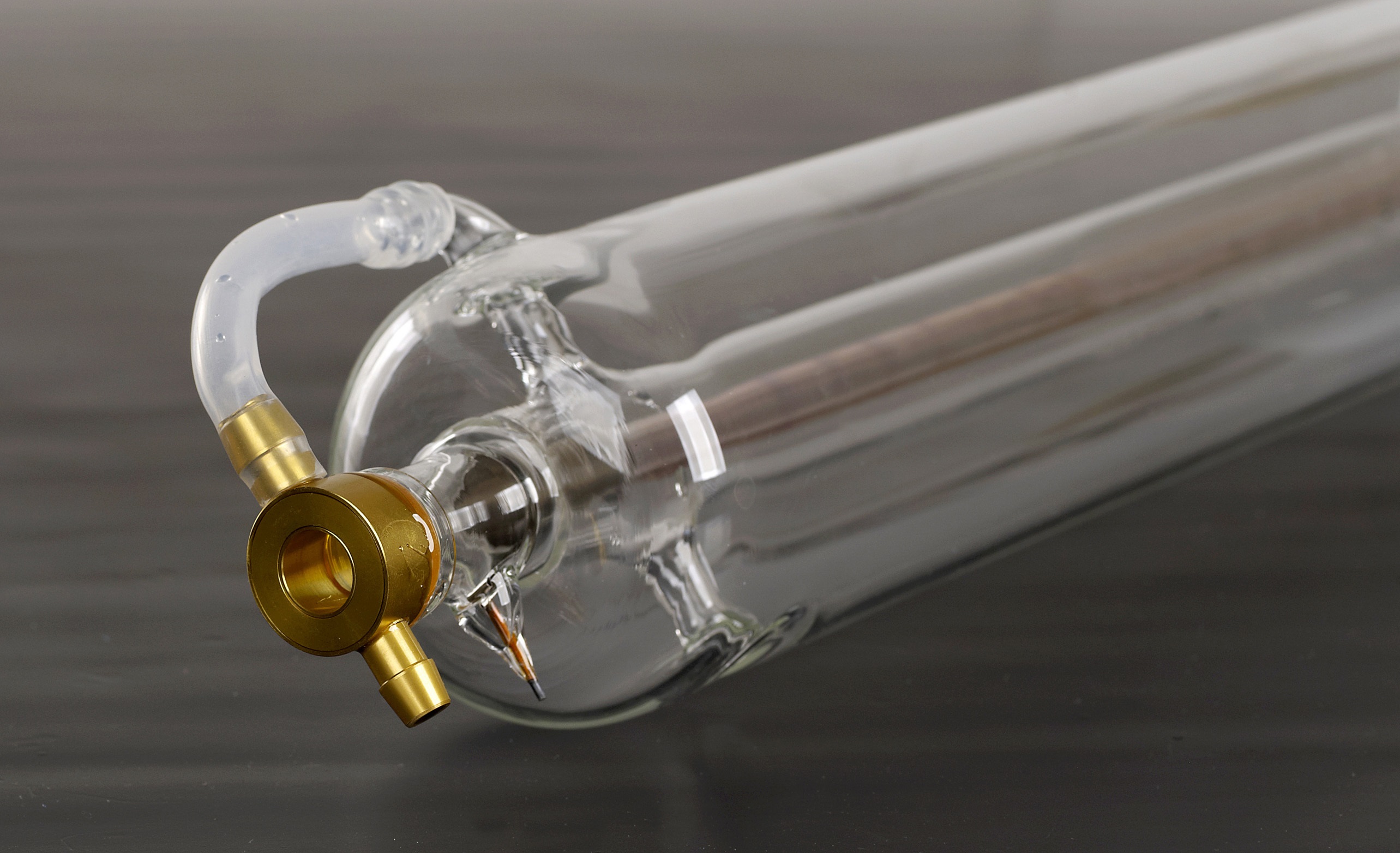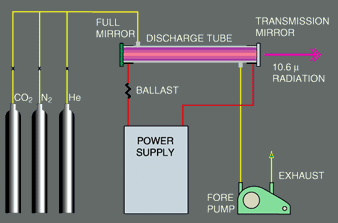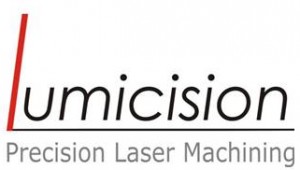CO2 lasers

Co2 laser tube

Co2 laser principle
–
Definition: Lasers based on the combination of several gases that are enhanced and produced by light carbon dioxide molecules.
A laser CO2 laser that operates on a gas mixture as an active ingredient, a mixture of CO2, helium, nitrogen and a small amount of hydrogen, water vapor or xenon gas (Xe). In this type of laser, the blower is electrically driven by an electric discharge in an environment with a current of AC or DC (e.g., between 20 and 50 kHz), or by radio frequency (RF). Nitrogen molecules are stimulated by an electrical discharge to an unstable vibrational level, and their excitation energy is transmitted to them when exposed to CO2 molecules. The role of helium is to reduce the population’s lower laser levels and eliminate heat. Other compounds, such as hydrogen or water vapor, can help reoxidize (especially closed tube lasers) carbon monoxide (which forms during evaporation).
CO2 lasers typically emit 10.6 micrometers at wavelengths, but other wavelengths range from 9 to 11 micrometers (especially 9.66 microns). In most cases, the average power is between tens and several kilowatts. Power conversion efficiency reaches a maximum of 10%, which is more than most solid-state lasers with a bulb blow, but this is less than the efficiency of most lasers with a diode blower.
Types of lasers
For power between several watts and several hundred watts, laser tubes are usually closed or without flow (gas). In these lasers, the gas chamber and the laser core are completely closed in a tube. These lasers are coherent and small, and their life spans several thousand hours.
High-power slave lasers that are cooled by playback (do not mislead solid-state slab lasers), which is parallel to the gap between the RF electrodes. If the distance between the electrodes is sufficiently small compared to the width of the electrodes, the excess heat is adequately transmitted through the electrodes through the diffusion. The output power of these lasers reaches several kilowatts.
Quick-flow and fast-current flow-fast lasers are suitable for multi-kilowatts for continuous wave outputs. The excess heat is transferred by the rapid flow of the gas mixture into an external coolant, and the gas returns to the system and reused in the evacuation.
Atmospheric stimulation lasers (TEAs) in which atmospheric pressure is high (high). Since the voltage required for longitudinal drainage is very high, a cross-sectional excitation is performed by a series of electrodes along the tube. TEA lasers work only in pulsed mode, which is due to instability of electrical drain on gas at high pressures. These lasers typically produce output power of less than 100 watts, but they can be made for potentials up to tens of kilowatts (combined with high repeat rate pulses).
There are several gas-dynamic CO2 lasers with several megawatts of power (used for anti-missile weapons), whose energy is not produced by gas evaporation in gas, but produced by a chemical reaction, such as a rocket engine.
The differences are mainly in the heat transfer and exit techniques, but there are differences in the gas pressure and the geometry of the electrodes. In low-power tube lasers (such as engraving lasers), excess heat is transferred to the tube walls by diffusion or cooled by a low gas flow. The radiation quality can reach very high values. High-CO2 CO2 lasers use a fast gas convection system, which may be coherent (parallel to the pathway) or cross-sectional (for high power).
Applications
CO2 lasers are widely used in the processing of materials, especially in the following cases:
Laser Cutting of plastic materials, wood, molded boards and so on, their absorbance is high at 10.6 micrometers and the average power is between 20 and 200 watts.
laser Cutting and welding metals such as stainless steel, aluminum or copper, which require power up to a few kilowatts.
Laser engraving of various materials
Other uses include laser surgery (including ophthalmology) and distance measurement.
CO2 lasers used in the processing of materials (for example, welding and cutting metal or laser engraving) are competing with solid-state lasers (especially yogurt and fiber lasers) with a wavelength of 1 micrometers. The shorter wavelengths have better advantages in terms of the greater absorption of metal parts and the ability to transmit radiation through fiber cables. (There is no optical fiber for laser rays with a wavelength of 10 micrometers and no high power). Also, the smaller product of the 1 micrometer laser beam may be very useful. But this feature can not be produced on high-power bulbs with a bulb and a diode for a high cost. Because of this, CO2 lasers are still widely used in the welding and cutting industry, and especially in high-thickness millimeters, accounting for 10% of all lasers sold in 2013, due to the progress of lasers in the coming years. Thin discs and fiber cables, and techniques for improving the quality of these types of lasers vary.
Due to the high power of these lasers and the high input voltage, safety issues regarding these lasers are very important. Although high-wavelength operation, working with these lasers at low density can be low for the eye.
